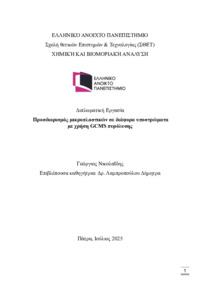- MSc thesis
- Χημική και Βιομοριακή Ανάλυση (ΧΒΑ)
- 19 Ιουλίου 2025
- Ελληνικά
- 74
- Δρ. Λαμπροπούλου, Δημητρούλα
- ΛΑΜΠΡΟΠΟΥΛΟΥ ΔΗΜΗΤΡΑ +ΤΣΙΑΦΟΥΛΗΣ ΚΩΝΣΤΑΝΤΙΝΟΣ + ΚΥΡΙΑΚΟΣ ΜΠΟΥΡΙΚΑΣ
- Pyrolysis με GC-MS | Ορισμός και ταξινόμηση μικροπλαστικών
- Σύγχρονη Χημική Ανάλυση ΧΒΑ50
- 7
- 4
- 11
- Περιέχει : Πίνακες, εικόνες
-
-
Η παρούσα εργασία εστιάζει στον προσδιορισμό και τη χημική χαρακτηριστική των μικροπλαστικών σε διάφορα περιβαλλοντικά υποστρώματα μέσα από μια θεωρητική, βιβλιογραφική προσέγγιση, με έμφαση στις αναλυτικές τεχνικές που βασίζονται στη θερμική πυρόλυση και την αέρια χρωματογραφία με φασματομετρία μαζών (Py-GC-MS). Τα μικροπλαστικά, λόγω της ευρείας παρουσίας τους σε υδάτινα, εδαφικά, ατμοσφαιρικά και βιολογικά περιβάλλοντα, αποτελούν σημαντικό πρόβλημα για τα οικοσυστήματα και τη δημόσια υγεία. Η εργασία εξετάζει συστηματικά τους ορισμούς, τις πηγές, τις φυσικοχημικές ιδιότητες, την περιβαλλοντική κατανομή και την παραμονή τους.
Ιδιαίτερη έμφαση δίνεται στα υποστρώματα όπου εντοπίζονται μικροπλαστικά, όπως θαλάσσια και γλυκά ύδατα, εδάφη και ιζήματα, η ατμόσφαιρα και οι ιστοί οργανισμών. Παρουσιάζονται οι αναλυτικές τεχνικές που χρησιμοποιούνται για την ανίχνευση και ποσοτικοποίηση μικροπλαστικών, περιλαμβάνοντας τη συλλογή και προετοιμασία δειγμάτων, τις οπτικές και φασματοσκοπικές τεχνικές (FTIR, Raman), καθώς και τις θερμικές μεθόδους.
Κεντρική θέση κατέχει η τεχνική Py-GC-MS, η οποία επιτρέπει την αναγνώριση των πολυμερών ανεξαρτήτως μεγέθους ή μορφολογίας. Η εργασία αναλύει τις αρχές λειτουργίας της πυρόλυσης και της GC-MS, ενώ εξετάζει τα πλεονεκτήματα του συνδυασμού τους στην ανάλυση μικροπλαστικών. Παρουσιάζονται παραδείγματα εφαρμογών της μεθόδου σε διαφορετικά υποστρώματα και αξιολογούνται τα πλεονεκτήματα και οι περιορισμοί της.
Τέλος, αναδεικνύονται οι ερευνητικές και τεχνολογικές προκλήσεις και προτείνονται κατευθύνσεις για μελλοντική έρευνα, όπως η ανάπτυξη πρότυπων πρωτοκόλλων, η αύξηση της αποδοτικότητας των μεθόδων και η εμβάθυνση στη μελέτη της τοξικότητας των μικροπλαστικών.
-
The present study focuses on the identification and characterization of microplastics in various environmental substrates through a theoretical, literature-based approach, with emphasis on analytical methods employing pyrolysis-gas chromatography-mass spectrometry (Py-GC-MS). Microplastics, due to their pervasive presence across aquatic, terrestrial, atmospheric, and biological environments, pose significant ecological and public health concerns. This work systematically explores their definitions, sources, physicochemical properties, environmental distribution, and persistence. Furthermore, the study examines the different environmental matrices where microplastics are found, such as marine and freshwater systems, soil and sediments, the atmosphere, and biological tissues.
Particular attention is given to the range of analytical methods available for detecting and quantifying microplastics, including sample collection and preparation procedures, optical techniques, spectroscopic methods such as FTIR and Raman, and thermal methods. The primary focus is placed on pyrolysis-GC-MS, a technique that allows for the polymer-specific identification of microplastics, regardless of their size, morphology, or surface contamination. The combination of pyrolysis and GC-MS offers enhanced sensitivity and selectivity, enabling the accurate quantification of microplastics in complex environmental matrices.
The study discusses the operational principles of pyrolysis and GC-MS individually, and then explores the analytical benefits of their integration. Applications of the Py-GC-MS method across different substrates are reviewed, highlighting its adaptability, robustness, and reliability. The method’s advantages—such as its capacity for polymer differentiation, quantification accuracy, and applicability to heterogeneous samples—are analyzed alongside its limitations, which include the need for high-cost equipment, specialized personnel, and complex interpretation of pyrolysis products. Concluding, the study identifies current scientific and technological challenges, and proposes directions for future research, such as the development of standardized protocols, improvement of analytical throughput, and expansion of knowledge on microplastic toxicity. The findings underline the central role of Py-GC-MS in modern microplastic analysis and its potential as a standard methodology for environmental monitoring and risk assessment.
-
- Hellenic Open University
- Items in Apothesis are protected by copyright, with all rights reserved, unless otherwise indicated.


